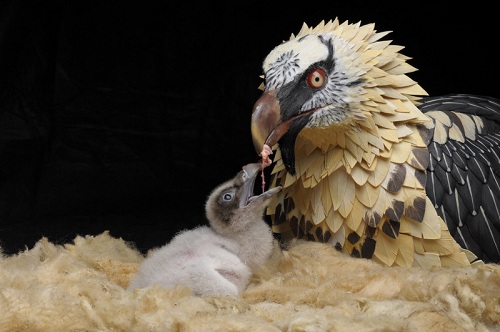Solar panels used to aid in monitoring endangered birds
 Imagine having the power to soar high above the Earth, and look down on civilization like you’re the head honcho of creation. Imagine living on the side of a cliff overlooking a beautiful landscape hundreds of feet above the ground. Now, imagine being on the endangered species list. It’s a stark contrast, but this is the everyday life of the Bearded Vulture (Gypaetus barbatus). Fortunately, a team of dedicated ornithologists (that’s a fancy way of saying bird scientist) is taking the necessary steps to look out for these endangered raptors. By setting up camera equipment powered by solar panels, these dedicated professionals spent four years researching and discovering what really goes on in the nests of Bearded Vultures.
Imagine having the power to soar high above the Earth, and look down on civilization like you’re the head honcho of creation. Imagine living on the side of a cliff overlooking a beautiful landscape hundreds of feet above the ground. Now, imagine being on the endangered species list. It’s a stark contrast, but this is the everyday life of the Bearded Vulture (Gypaetus barbatus). Fortunately, a team of dedicated ornithologists (that’s a fancy way of saying bird scientist) is taking the necessary steps to look out for these endangered raptors. By setting up camera equipment powered by solar panels, these dedicated professionals spent four years researching and discovering what really goes on in the nests of Bearded Vultures.
Four years ago, in 2006, Antoni Margalida, Stephane Ecolan, Jennifer Boudet, Joan Bertran, Jean-Michel Martinez, and Rafael Heredia set out to document the Bearded Vulture to learn more about its lesser known mating patterns and breeding biology. This was done by setting up a system of solar-powered still cameras, video cameras, and microphones above, and inside, the nests of the birds. The equipment was run off of a 12 volt battery pack which was charged by a small solar panel. According to the research published in the Journal of Field Ornithology, when fully charged, the battery lasted 3-4 days without any direct exposure to sunlight. When exposed to the sun, it only took 3 hours to completely charge. The solar powered equipment used was instrumental in allowing for minimal human intrusion into the Vulture’s habitat.
“Cameras reduce the potential negative effects the presence of a researcher would have on the breeding effort,” said Margalida. The luxury of having this equipment yielded excellent results.
The study was conducted over a four-year, or four breeding seasons, period, observing a total of 16 nest sites in the Catalan Pyrenees mountain range in the Northeast of Spain. Already knowing that the Bearded Vulture’s breeding season lasts from September—when the birds rebuild their nests—to July—when the young begin to fledge or develop the ability to fly—the team of ornithologists was able to focus in on the specific time frame their efforts might yield the best results. When the four-year trial was finished, the team found that on average 9 out of the 16 nest sites successfully mated. That’s a 56.3 percent success rate, which means the population is not only being replaced when it comes down to deaths versus births, but it also means that the Bearded Vulture population is actually growing. Not only that, but the team was able to gather invaluable data about other important aspects of the raptor’s lives. The solar powered recording equipment was able to document egg-laying intervals, incubation behavior, hatching asynchrony (a fancy way of describing the unpredictable way a baby bird will hatch from its shell), sibling aggression, and diet.
All of the data collected in the study is crucial to preserving the endangered Bearded Vulture for generations to come, but none of it would be possible without the technological innovations of solar energy.
Preservation is working in tandem with innovation these days. The possibility to use new innovative ideas to preserve our past is quite palpable, and solar energy has provided the window to look through the past and into the future.



